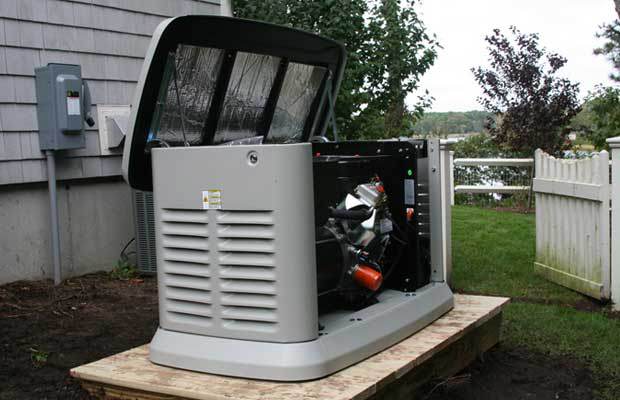Winter’s coming, and the nights are getting colder and longer…
Today’s post on another excellent prepper blog (Backdoor Survival) linked back to one of its recent posts on the subject of prepping for a power outage, a concern for us where we live, due to the extremes of our weather. Back before Y2K we embraced the idea of installing a standby generator at our home.
There are numerous approaches to living with the loss of normally sourced electricity, from sucking it up and lighting candles, to enlisting the use of portable generators, to investing in your own whole-house power generation capability, with which you could re-power literally everything in your house.
 The several comments following the Backdoor Survival article began with one from a fellow who has also chosen to invest in a “whole-house” generator, one fueled by the utility-company provided natural gas; his goal being that when the rest of the world goes dark, he and his family should be able to carry on normally with life in their home, as long as the fuel keeps flowing. Excellent decision.
The several comments following the Backdoor Survival article began with one from a fellow who has also chosen to invest in a “whole-house” generator, one fueled by the utility-company provided natural gas; his goal being that when the rest of the world goes dark, he and his family should be able to carry on normally with life in their home, as long as the fuel keeps flowing. Excellent decision.
Regarding his choice of a natural gas-powered generator vs. generators using other fuels: IMHO, he has chosen well…having an uninterrupted supply of fuel for your generator via your utility company’s natural gas hard-line is an excellent, extremely attractive option for a fixed-location (non-portable) generator. And from an “ease of operation” standpoint, under the “normal” circumstances he intimates (virtually anything short of a protracted SHTF event) it’s probably the best fuel choice for a generator in terms of simplicity and ease of use…because as long as that natural gas element of “The Grid” doesn’t go down, he shouldn’t ever need to worry about or deal with periodic manual refueling of his generator, or concern himself about safe fuel storage and rotation, fuel preservative additives, etc.
I often wonder, as a matter of comparison, how much use other people’s standby generators get, and what circumstances and conditions exist when their generators are most often called into service. We live in the West at about 5000′ elevation, and we lose power most often in the warmer months due to lightning strikes on transformers during thunderstorms, and with the high winds in the colder months; and on a couple of occasions over the last 16 years, powerful blizzards with heavy snows have taken down power transmission lines, darkening the whole region for a while.
When choosing a whole-house generator, size definitely matters. For our home, we chose a 15KW diesel-powered, trailer-mounted “whole-house” generator unit. (Frankly, I am certain that we could overload it and induce an auto-shutdown if we turned on every light and ran every appliance at the same time; but since we don’t live like that, it has never happened in the 16+ years we’ve had the generator, so we’re comfortable with its size and performance, and its fuel economy.
Our generator/ trailer rig sits parked (and securely locked down) on its pad next to the house. It connects to our Main Breaker Panel through an Automatic Transfer Switch, which eliminates the steps of going outside in the weather to the Main Breaker Panel, disconnecting the “street power” Main Breaker, then manually starting up the generator, closing the generator breaker that connects generator power to the Main Breaker Panel; and undoing those steps in reverse order once “street power” becomes available again. And that is a beautiful thing.
The added utility of this setup is that the generator/ trailer rig can easily be disconnected from the transfer switch, allowing us to tow it to other locations/ venues to provide a temporary power source for emergency use, construction work, or events. Moreover, in a “Bug-Out” situation, we could conceivably hook it up to the truck and take it with us to…wherever.
With OPSEC high on the hierarchy of concerns for many preppers, operating a generator can be a double-edged sword —  while providing much-needed electricity, generators can make a lot of noise and can be a dead giveaway to their own presence during a dark and otherwise silent night. Depending on circumstances, that might not be a big deal. Still, if anyone reading this is considering buying a standby generator, be aware that many — if not most — generators turn at 3600 RPM and can indeed be noisy, while some generators operate at half that, a much quieter 1800 RPM…it’s no problem to carry on a conversation in close proximity to our generator while it’s operating, without having to shout over the din. Might be worth looking into.
while providing much-needed electricity, generators can make a lot of noise and can be a dead giveaway to their own presence during a dark and otherwise silent night. Depending on circumstances, that might not be a big deal. Still, if anyone reading this is considering buying a standby generator, be aware that many — if not most — generators turn at 3600 RPM and can indeed be noisy, while some generators operate at half that, a much quieter 1800 RPM…it’s no problem to carry on a conversation in close proximity to our generator while it’s operating, without having to shout over the din. Might be worth looking into.
Also, if anyone reading this is considering getting a “whole-house” generator setup, I’d like to strongly recommend investing in an Automatic Transfer Switch (ATS, or maybe better to call it an AT$)…after all these years, we absolutely love having it for both the safety and convenience it provides; and we’re content having coughed up the considerable extra cost. If you don’t want to spend the money right away, acquire the generator first, so you have standby power when needed; later on you can acquire an Automatic Transfer Switch for the safety and convenience it provides. If you’re not familiar with the operation of an ATS, here’s how one (ours) works:
The utility company’s “Street Power” is the “normal” source of electricity to our house. When the Automatic Transfer Switch (ATS) “brain” senses a fluctuation or interruption of “street power”, the ATS first automatically isolates the Main Breaker Panel from “street power” (to prevent “back-feeding” of power from the operating generator to the street — a very dangerous, possibly deadly condition); and simultaneously the ATS “brain” sends a signal to start the generator. Once the ATS “brain” senses that the generator is “up to speed” (about 5 seconds) and supplying usable, safe power, the ATS “brain” selects “generator power” to re-power the Main Beaker Panel, and Voila!…we’re back up and running. Later, when the ATS “brain” senses that “street power” is once again available and stable, the ATS simultaneously de-selects “generator power” and re-selects “street power” as the source of power to the main panel, restoring availability to the house. The ATS “brain” then provides the generator with a “cool down” period of a few minutes before sending the signal to the generator to shut itself down. The ATS automatically “re-arms” for the next interruption of “street power”. And I didn’t have to get out of my chair to make any of that happen…sweet!
(A note about that ATS “brain”…as I write this, I find myself wondering for the first time how that computer circuitry might fare during an EMP…no clue. Does anyone know?…Anyone?…Bueller?)
Regarding fuel economy, under load, our generator consumes under 1 GPH (one gallon per hour) of diesel fuel, in fact more like 0.6 GPH max. With its 16-gallon fuel tank, that translates into a good 24 hours of continuous generator operation before refueling becomes necessary. Luckily we’ve never gone that long without normal “street power”, but then we don’t live in Seattle, which, according to the Backdoor Survival article, was without power for “almost a week”. If a power failure here should persist longer than 24 hours, then we would be required to take steps to “safely” refuel the generator (meaning shutting it down during the refueling process and going without power until the refueled generator is back up and providing power again)…and THERE you have the major advantage of choosing a standby generator powered by natural gas. Of course, under complete “Grid-Down” conditions, natural gas could become unavailable, as could all types of generator fuels.
The presence of our standby generator has long provided us with a deep sense of security; and we sheepishly admit to experiencing a perhaps perverse “warm, fuzzy feeling” when the neighborhood goes dark, and after only a few seconds in that darkness our house automatically returns to normal ops, while we will remain warm and snug and contentedly watching TV or whatever, rather than bringing in more wood for the fire and getting out the blankets, and looking for the matches to light those lanterns and candles.
Bottom line: “Getcha one if you can…you’ll be glad you did!”
If you found this article useful, please Vote for The Prepper Journal as a top prepper web site.
Copyright Information This information has been made available by The Prepper Journal. Content on this site (unless the work of a third-party) may be shared freely in digital form, in part or whole, for non-commercial use with a link back to this site crediting the author. All links in articles must remain intact as originally posted in order to be republished. If you would like to be notified of new articles, contests and Prepper news, please sign up for our daily newsletter.






Natural gas supply is getting less and less reliable as providers switch over to electric compressor stations which are less expensive and do not require a permit from the EPA.
Blackouts can sometimes be a good initiation for some bonding time with friends/family but it’s still an interruption from your daily life so backup generators will come in handy if you have that report to finish.